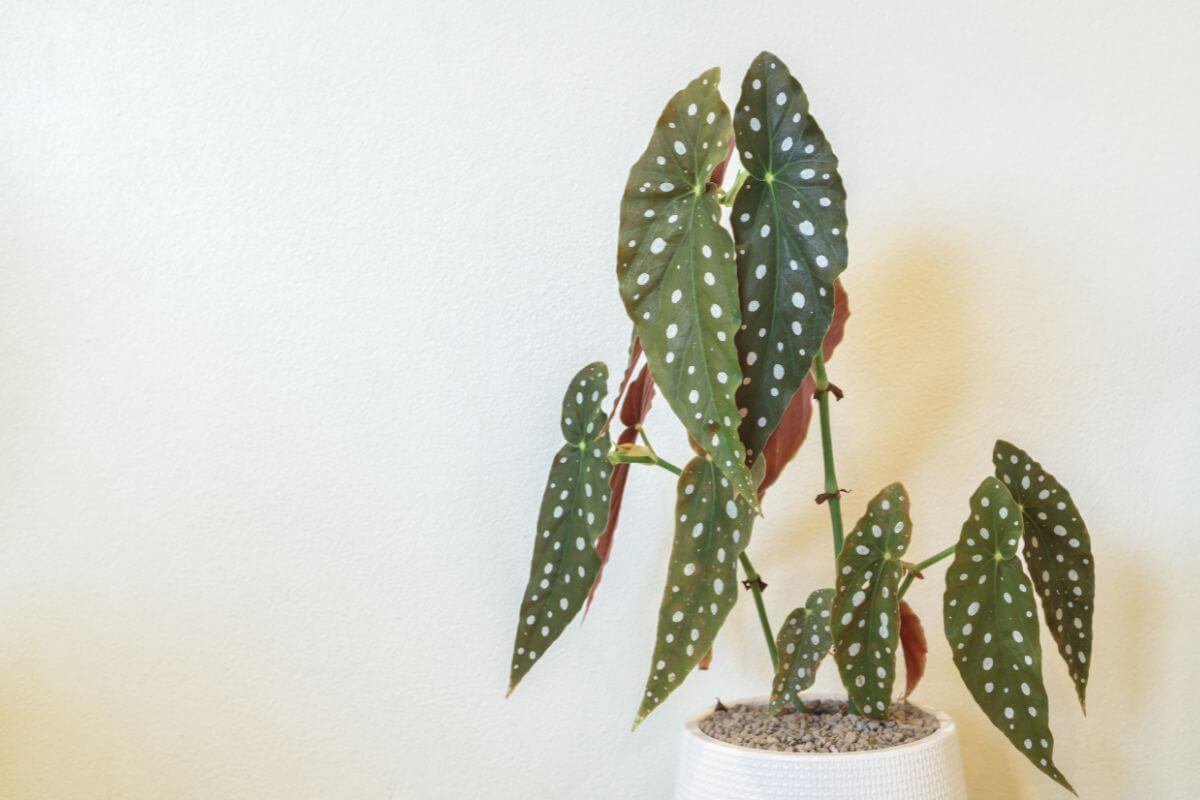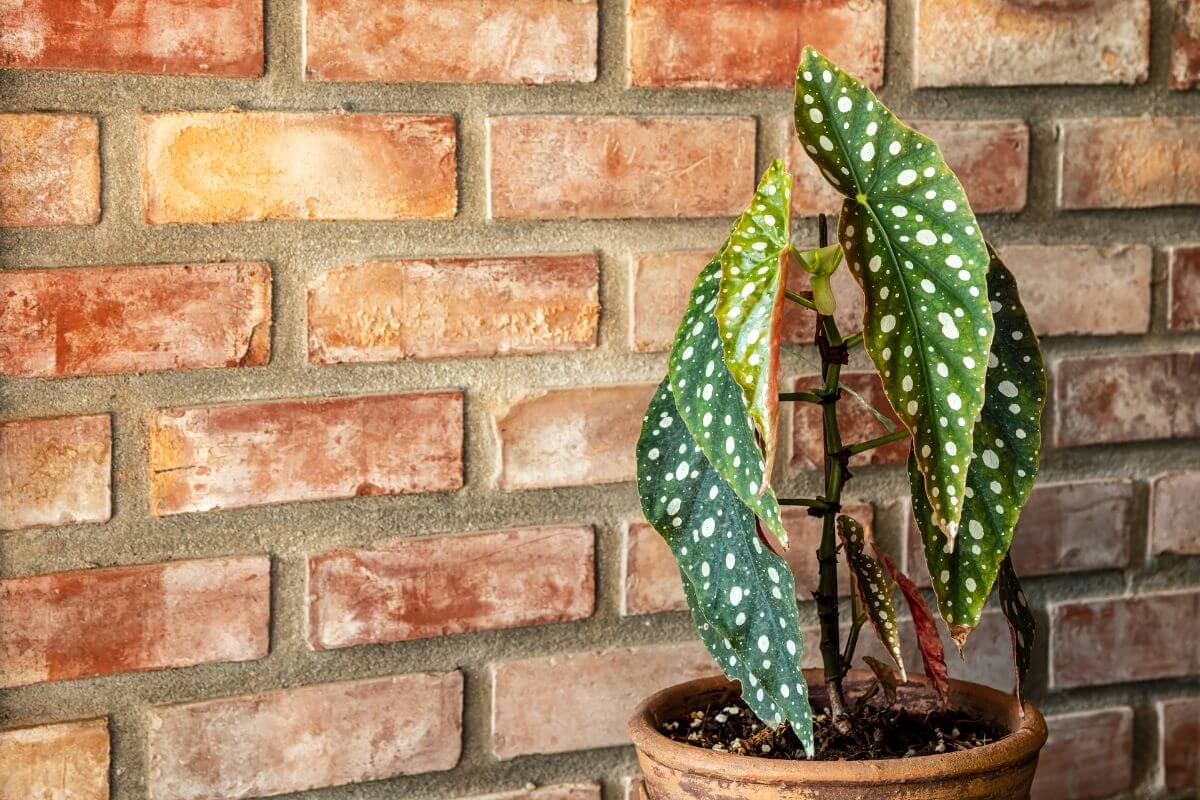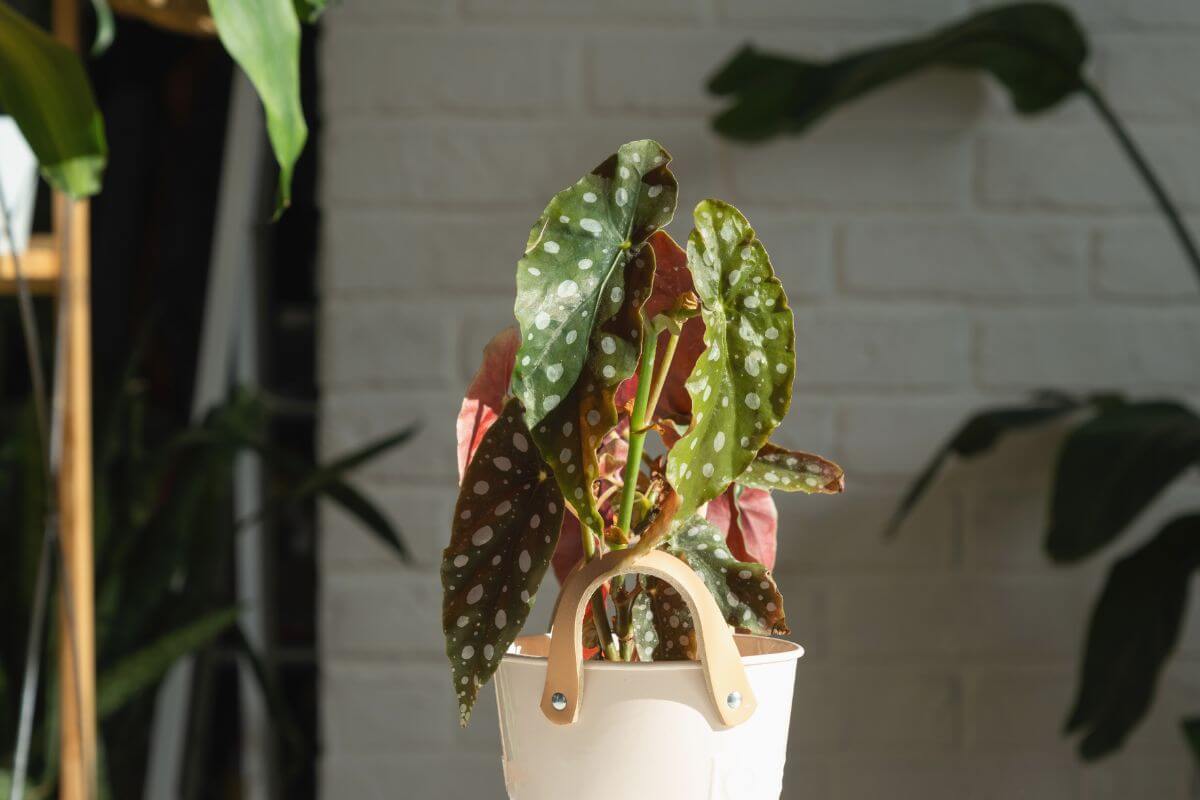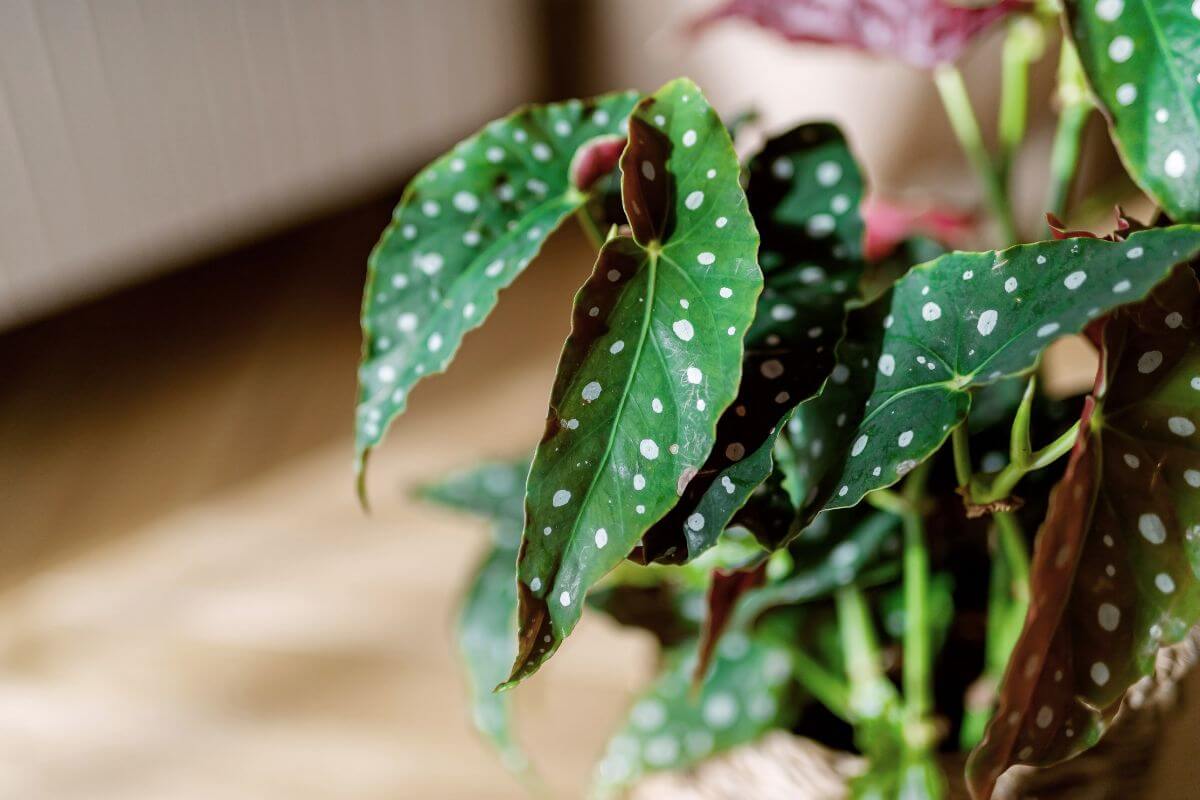The Begonia Maculata is a beautiful plant with a long history of being used as a houseplant. It has a large range of colors, grows quickly and requires little care.
This begonia is perfect for beginners who want to learn how to grow plants indoors.
In this guide, I’ll teach you everything you need to know about growing and caring for the Begonia Maculata plant, including the right potting soil, how to water, fertilize, and repot.
Begonia Maculata Overview

Botanically known as the Begonia Maculata or Begonia Wightii, this beautiful houseplant can be cultivated indoors, as well as outdoors.
A member of the Begoniaceae family and native of Brazil’s southeast Atlantic rainforest, it is also called the Polka Dot Begonia Plant, the Clown plant, or the Spotted plant.
Characterized by large, dark green and deeply veined foliage shaped like angel wings, they feature silvery-white polka dots on the leaf tops and red undersides.
They bloom white flowers that are small and bell-shaped, growing in sprays. Flowers come in a variety of colors including white, yellow, pink, or red. Unique patterns and shapes contribute to an exotic-looking plant that is most certainly a showstopper.
The Begonia Maculata will grow up to 5 feet tall with asymmetric leaves that can grow up to 8 inches long.
This Polka Dot Begonia is relatively fast-growing and short-lived. Its normal lifespan may not exceed three years although it is easily propagated.
Note: this is a different plant from the Polka Dot Plant (Hypoestes phyllostachya) that also has polka dot leaves.
Begonia Maculata Care Guide
An elegant, naturally polka-dotted plant, it may appear like a difficult plant to cultivate, but it is actually a relatively easy to care for. Even as a low-maintenance plant, it still has preferences when it comes to its growing conditions.
Soil for the Begonia Maculata

Like so many houseplants, the Begonia Maculata prefers well-draining soil that is kept moist, but avoid soggy soil.
It will do fine in commercial potting soil, but the soil should be amended with a handful of non-toxic wood chips to increase aeration. Wood chips do eventually decompose, but your Begonia will have been repotted before this takes place.
Amend the soil with one part perlite to increase drainage capability. Note that perlite and vermiculite are not interchangeable as vermiculite will retain more moisture.
Also, add in a handful of organic fertilizer or organic compost. Good air circulation will contribute to the overall health of the plant.
Light for the Begonia Maculata
The Begonia Maculata thrives in bright indirect light. Direct sunlight exposure can lead to fading polka dots or scorched leaves.
While this plant can adapt to low light environmental conditions, it will not have strong growth if the lighting is very dim.
In cooler climate regions, you can place the plant in bright spots by the windows that don’t have direct sunlight. While in the southern regions, the plants should be placed in partial shade.
If the foliage appears to lose color and turn into yellow leaves before dropping, you will know that the light is insufficient. Brown leaves and scorching indicate too much light. Direct exposure to sunlight should be avoided.
Water and Humidity for the Begonia Maculata
While the Begonia Maculata needs moist soil to thrive, it can benefit from allowing the soil bed’s top half-inch to dry between waterings.
If the plant is overwatered, it’s at risk for root rot, so the soil should not be allowed to become waterlogged or soggy. Permitting the top inch of soil dry out will also ward off fungal infections and gnats. It is preferable to practice bottom watering and avoid leaves from getting wet.
As a rainforest native, the Begonia Maculata enjoys higher humidity. If you live in a humid climate, your plant should do fine. If not, higher humidity can be accomplished by grouping plants to raise the humidity in the area together or you can use a humidifier.
A pebble tray is another option for increasing humidity levels, which should measure 45% or higher.
Temperature for the Begonia Maculata

As a rainforest native, the Polka Dot Begonia plant likes the comfortable temperatures of the indoors, but not below 60°F. It should be protected from cold drafts and positioned in your home with this in mind.
The ideal temperature for this plant will measure between 65° and 85°F. but it can endure somewhat warmer temps for short periods of time.
As an outdoor plant, it should be cultivated in USDA hardy zone 10. If you are cultivating your plant outside, move it indoors in cooler regions before the first frost arrives.
Fertilizer for the Begonia Maculata
As a flowering plant, you should feed the Begonia Maculata occasionally. Feed only during the growing season using a water-soluble standard 20-20-20 fertilizer.
Dilute the fertilizer to half strength and use it during waterings every other week, so your plant is fed every two weeks.
Pruning the Begonia Maculata
One risk of the Polka Dot Begonia is that it will become leggy as it grows. To cultivate a bushier plant, pinch it back during the growing season.
Pinch or snip off any new stems that branch off from the principal stem. This will stimulate double growth where you have pruned.
If your plant grows tall, prune it back to a shorter height towards the end of autumn when the growing season ends. Growth will slow considerably in the winter months.
Repotting the Begonia Maculata

Ideally, your Polka Dot Begonia plant should be repotted annually to a larger pot size. This Begonia does not mind being a little root bound, but take care that the soil does not exhaust its nutrients.
Annual potting with fresh soil will prove to be beneficial. As these plants tend to be top-heavy, the container you choose should be heavy such as clay, terracotta, or stone. Or if you use a plastic container, place it inside a heavier flowerpot.
Propagating the Begonia Maculata
This spotted plant can be grown from seeds or more easily through propagation with cuttings. Cuttings can be either stem cuttings or leaf cuttings.
Propagate the Begonia Maculata with Stem Cuttings
Rhizomes are used when cultivating Begonia Maculata stem cuttings. These are thick stem sections that are cultivated under the soil surface.
Cut a rhizome section that is approximately one inch long and slide it under the soil surface in a pot filled with well-draining soil or peat. The soil bed should remain moist, but not soggy.
They should be kept in a warm place with bright indirect sunlight, but out of direct sunlight until roots form. This will usually take about six weeks.
Propagate the Begonia Maculata with Leaf Cuttings
Cut several fresh leaves from your plant. Place the leaves on a flat surface upside down. Using a sterilized sharp knife slice them into wedges. Each wedge must contain a vein.
If you only want a few plantlets use leaves directly and leave one inch of petiole attached to the leaves.
Fill a container with well-draining potting soil. Place the petioles or leaf wedges into the soil. Water so that the cuttings are moist, but not overly wet.
Place the container in a plastic bag and store it in a warm area out of direct, strong sunlight. Roots should appear after about a month. After six weeks, your plantlets should be ready for transplanting.
Leaf cuttings can also be propagated in a glass of water. When roots grow to about one-half inch, the plantlets can be transplanted into soil.
Propagate the Begonia Maculata with Seeds
Propagating your plant from seeds may be a bit more difficult and will certainly require more time. Most people avoid this method as seeds are tiny and more difficult to handle. Use seedling trays and fill them with sterilized potting soil for seeding.
Place and press the seeds against the soil bed without covering them. Water the seeds with a mister and cover the tray with plastic. Place them in a warm well-lighted location.
You may need a few weeks to months for the seeds to germinate. Seed trays should be watered to keep the soil moist. Once the seeds begin germinating remove the plastic.
When seedlings develop their first true leaves they can be transplanted into individual pots.
Begonia Maculata Toxicity and Pets
The American Society for the Prevention of Cruelty to Animals (ASPCA) indicates the Begonia Maculata as toxic to pets. It contains soluble calcium oxalates, with the most toxic part of the plant being underground.
The Begonia will cause swelling and severe burning internally and externally. Toxic symptoms may affect the mouth, throat, tongue, and skin of pets. Swelling can become so severe that an animal will have difficulty making sounds, breathing, and can be lethal, leading to death.
Symptoms to watch for include:
- Pawing at the mouth
- Excessive drooling or salivation
- Vomiting
- Lessened appetite
- Swollen lips, tongue, or mouth
- Mouth irritation and pain
- Swallowing difficulty
- Mouth sores
Usually, animals will stop after the first bite because of the burning sensation. Death can occur in domestic pets if they munch on large amounts of foliage.
Should a pet eat a begonia, the mouth and skin should be rinsed immediately. Should swelling begin, a veterinarian should be contacted.
If poisoning symptoms are severe, get to a veterinarian or animal emergency hospital immediately.
Begonia Maculata Pests, Diseases and Problems

While not overly sensitive, like all indoor houseplants, the Begonia Maculata will suffer from a few problems that are common to many plants.
Pests are not common, but your begonia is susceptible to mealybugs and whiteflies. Mealybugs appear as white cottony deposits on stems and leaves. They can be removed by hand or with a cotton ball dipped in alcohol.
Sap-sucking aphids and thrips can attack your begonia. They will probably be too microscopic to be visible, but you’ll notice the damage to your plant.
Both organic insecticidal soaps and neem oil can be used to treat the plant and remove the pests.
The Polka Dot Begonia plant is susceptible to Powdery Mildew, which is a fungal infection that coats leaves with a powder. It is usually caused by wet foliage and high moisture levels.
It’s better to water your begonia at the base of the plant as opposed to overhead watering to prevent foliage from becoming wet. If your plant develops this infection, apply a fungicide.
Another fungal infection to beware of is Botrytis. It will cause leaves to develop brown spots on lower leaves that are soggy in texture. Trim away any affected foliage and apply a fungicide.
Bacterial Leaf Spot can be a problem. If your plant becomes infected, it will show pimple-like spots. You can attempt to remove infected leaves, but if the plant is heavily infected it should be destroyed, and the soil removed and disposed of. That will help prevent the disease from transferring to your other houseplants.
One problem this plant faces is leaning because it will eventually grow top-heavy. This can be resolved by using a small trellis, stakes, or thin bamboo in your pot, and tying your plant with soft string.
Should foliage turn yellow and begin dropping, it is usually a case of overwatering. Allow soil to dry out before watering anew and water less often.
Another risk of overwatering is the development of stem and Pythium Root Rot. Damaged roots can be trimmed, and the plant replanted in fresh potting soil. Discard any ill plant or plants parts.
Brown tips on leaves is generally a result of underwatering. Another symptom of insufficient water is drooping leaves and stems. Give your plant a soak and allow it to drain completely before returning it to its normal location.
Final Thoughts on the Begonia Maculata
The Begonia Maculata is an exotic-looking, fast-growing houseplant. It’s stunningly beautiful and features silver polka dots on a dark green background and red-tinted undersides.
With the right conditions, it is a low-maintenance plant that is easy to care for and will be a stunning addition to any décor.
Here are some other houseplants you might enjoy:



Informative care article for my new Begonia Maculata plant!
Thanks Susan! The Begonia Maculata is beautiful!